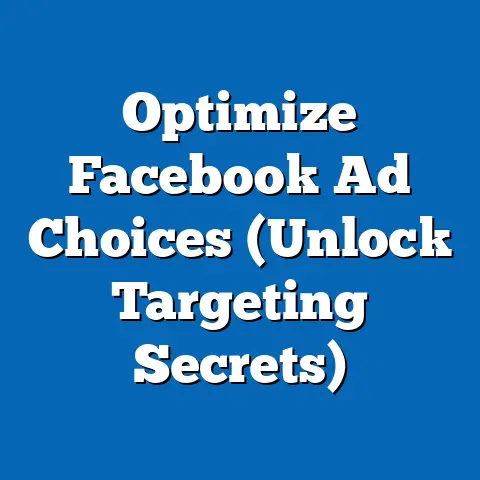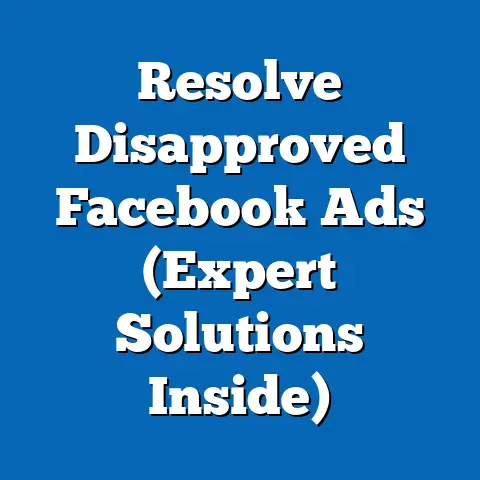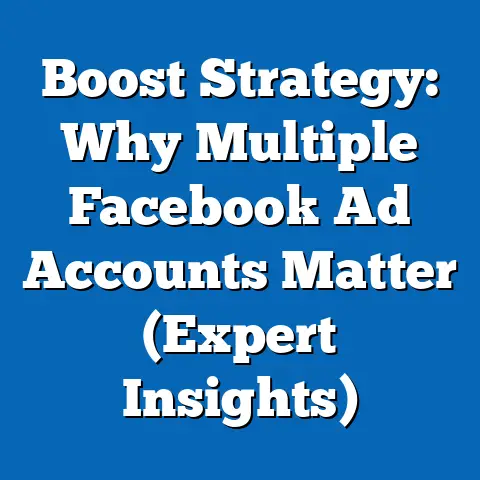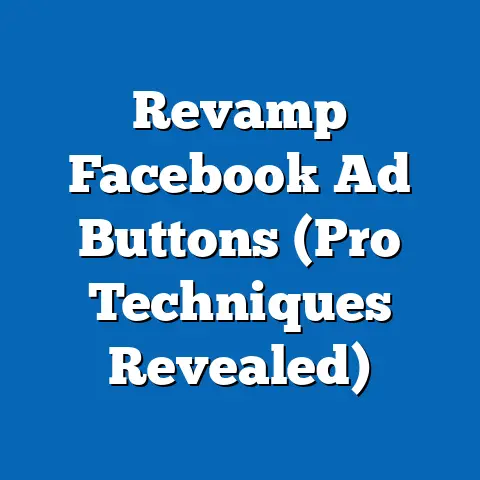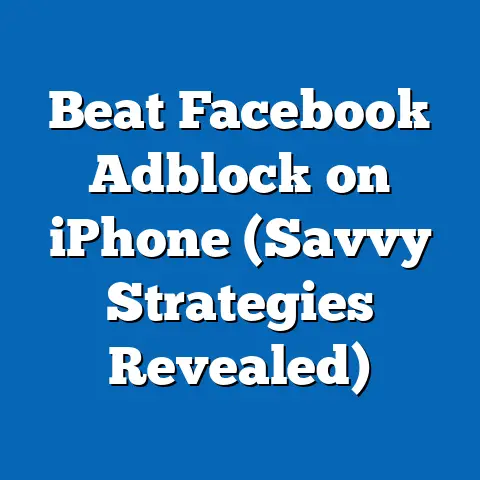Understanding Facebook’s Instagram Ad Charges (Expert Insights)
In today’s digital landscape, Instagram has emerged as a powerhouse for advertising, captivating audiences with its visually driven platform and engaging content formats. As an expert in the field, I’ve witnessed firsthand the transformative impact Instagram has had on businesses of all sizes. It’s not just about posting pretty pictures anymore; it’s about strategically leveraging the platform to connect with your target audience, drive conversions, and build brand loyalty. In 2023, Instagram generated over $40 billion in advertising revenue, accounting for nearly 30% of Facebook’s total ad revenue, a testament to its growing importance in the advertising world. This staggering figure highlights the need to understand the intricacies of Instagram ad charges and how to optimize your campaigns for maximum ROI.
This guide will delve into the world of Instagram advertising costs, providing you with expert insights and actionable strategies to make the most of your budget. I’ll break down the pricing models, explore the factors that influence ad costs, offer budgeting tips, and discuss how to measure your ROI. Plus, I’ll share my predictions for the future of Instagram advertising charges. Let’s dive in!
Overview of Instagram Advertising
Instagram advertising is a powerful way to reach a highly engaged audience, leveraging the platform’s vast reach and sophisticated targeting capabilities. It’s deeply integrated with Facebook’s advertising ecosystem, allowing you to manage your Instagram campaigns through the same Ads Manager you use for Facebook ads. This seamless integration makes it easy to create, track, and optimize your campaigns across both platforms.
Ad Formats on Instagram
Instagram offers a variety of ad formats to suit different marketing objectives and creative styles:
- Photo Ads: These are simple yet effective ads that feature a single image with accompanying text. They’re great for showcasing your product or service in a visually appealing way.
- Video Ads: Video ads are ideal for capturing attention and telling a story. They can be used to demonstrate product features, share customer testimonials, or create engaging brand content.
- Carousel Ads: Carousel ads allow you to showcase multiple images or videos in a single ad unit. This format is perfect for highlighting different aspects of your product or service, or for telling a sequential story.
- Stories Ads: Stories ads are full-screen ads that appear between users’ organic stories. They’re highly immersive and can be used to drive brand awareness, generate leads, or promote special offers.
Significance of Instagram in Digital Marketing
Instagram’s appeal lies in its visual nature and its popularity among younger demographics. If your target audience is primarily Gen Z or Millennials, Instagram is a must-have in your digital marketing arsenal. Its ability to drive engagement, build brand awareness, and generate leads makes it a valuable platform for businesses of all sizes. I’ve seen countless businesses transform their online presence and drive significant revenue growth through well-executed Instagram advertising campaigns.
Understanding the Pricing Model
Instagram advertising uses a bidding system, where advertisers compete for ad space based on their target audience, ad quality, and budget. Facebook’s algorithms then determine which ads to show to which users, based on a variety of factors. Understanding the pricing models is crucial for optimizing your ad spend and achieving your marketing goals.
Primary Pricing Models
Here are the primary pricing models used for Instagram ads:
- Cost Per Click (CPC): With CPC, you pay each time someone clicks on your ad. This model is ideal for driving traffic to your website or landing page. I often recommend CPC for campaigns focused on generating leads or driving sales.
- Cost Per Thousand Impressions (CPM): CPM means you pay for every 1,000 times your ad is shown to users. This model is best for increasing brand awareness and reaching a large audience. If your goal is to get your brand in front of as many eyes as possible, CPM is a great option.
- Cost Per Action (CPA): CPA allows you to pay only when someone takes a specific action, such as making a purchase or filling out a form. This model is the most performance-driven and is ideal for campaigns focused on conversions. While CPA can be more expensive upfront, it often delivers the highest ROI.
Choosing the Right Pricing Model
The best pricing model for your campaign depends on your specific objectives. If you’re focused on driving traffic, CPC is a good choice. If you want to increase brand awareness, CPM is more suitable. And if you’re aiming for conversions, CPA is the way to go.
I always advise my clients to start by defining their campaign goals and then selecting the pricing model that aligns best with those goals. Don’t be afraid to experiment with different models to see what works best for your business.
Factors Influencing Ad Costs
Several factors can influence the cost of your Instagram ads:
- Audience Targeting: The more specific your target audience, the higher the cost per impression or click. This is because you’re competing with other advertisers who are targeting the same niche audience.
- Ad Placement: Ads placed in more prominent locations, such as the Instagram feed, tend to be more expensive than ads placed in less visible areas, like the Explore page.
- Seasonality: Ad costs can fluctuate depending on the time of year. During peak seasons like holidays or major sales events, demand for ad space increases, driving up prices.
Factors Affecting Instagram Ad Costs
Now, let’s delve deeper into the specific factors that can significantly impact your Instagram ad costs. Understanding these elements will empower you to make informed decisions and optimize your campaigns for better performance.
Competition for Ad Space
One of the primary drivers of Instagram ad costs is the level of competition for ad space. Just like in any auction, the more advertisers vying for the same audience, the higher the prices will be. This competition is especially fierce in popular niches and during peak advertising seasons.
My Tip: To mitigate the impact of competition, consider targeting less saturated audiences or experimenting with different ad placements. You can also try running your campaigns during off-peak hours when competition is lower.
Audience Targeting
Your audience targeting strategy plays a crucial role in determining your ad costs. Targeting a broad audience may seem like a cost-effective approach, but it can actually lead to higher costs in the long run. This is because your ads will be shown to many users who are not interested in your product or service, resulting in low engagement and wasted ad spend.
On the other hand, targeting a highly specific audience can increase your costs per impression or click, but it can also lead to higher conversion rates and a better overall ROI. The key is to strike a balance between audience size and relevance.
My Experience: I once worked with a client who was targeting a very broad audience with their Instagram ads. After analyzing their campaign data, I recommended narrowing their focus to a more specific demographic. The result was a significant increase in engagement and conversion rates, and a lower cost per acquisition.
Ad Quality and Relevance Scores
Facebook’s algorithms assign a quality and relevance score to each ad, based on factors like engagement rate, click-through rate, and user feedback. Ads with higher scores are rewarded with lower costs and better placement, while ads with low scores are penalized.
Why This Matters: Your ad quality and relevance scores are a direct reflection of how well your ads resonate with your target audience. If your ads are engaging, informative, and relevant, they’re more likely to receive positive feedback and achieve high scores.
My Advice: Focus on creating high-quality, visually appealing ads that speak directly to your target audience’s needs and interests. Test different ad creatives and messaging to see what performs best. And always monitor your ad quality and relevance scores to identify areas for improvement.
Budgeting for Instagram Ads
Creating an effective budget for your Instagram ad campaigns is essential for maximizing your ROI and achieving your marketing goals. Without a well-defined budget, you risk overspending or underspending, both of which can negatively impact your results.
Setting Daily vs. Lifetime Budgets
Instagram offers two primary budgeting options: daily budgets and lifetime budgets.
- Daily Budgets: With a daily budget, you set a fixed amount that you’re willing to spend each day. This option is ideal for campaigns that run continuously over an extended period.
- Lifetime Budgets: With a lifetime budget, you set a total amount that you’re willing to spend over the entire duration of your campaign. This option is best for campaigns with a specific start and end date, such as a product launch or a seasonal promotion.
My Recommendation: I typically recommend using daily budgets for ongoing campaigns and lifetime budgets for time-sensitive promotions. This allows you to maintain consistent ad spend while also controlling your overall budget.
Allocating Funds Across Ad Sets
If you’re running multiple ad sets within a single campaign, it’s important to allocate your budget effectively across each ad set. This ensures that you’re not overspending on underperforming ad sets and that you’re giving your best-performing ad sets the opportunity to reach their full potential.
How to Do It: Start by analyzing the performance of each ad set. Identify the ad sets that are generating the most engagement, conversions, and ROI. Then, allocate a larger portion of your budget to those ad sets.
My Insight: Don’t be afraid to reallocate your budget as your campaign progresses. If you notice that one ad set is consistently outperforming the others, consider increasing its budget to maximize your results.
Monitoring and Adjusting Budgets
Your budget isn’t set in stone. It’s important to monitor your campaign performance regularly and adjust your budget as needed. If you’re seeing positive results, you may want to increase your budget to reach a larger audience. If you’re not seeing the results you want, you may need to decrease your budget or reallocate it to other ad sets.
My Strategy: I recommend checking your campaign performance at least once a day, especially during the first few days of your campaign. This allows you to identify any issues early on and make adjustments before they impact your results.
Measuring ROI on Instagram Ads
Measuring the return on investment (ROI) for your Instagram ads is crucial for determining the effectiveness of your campaigns and making informed decisions about your future ad spend. Without accurate ROI data, you’re essentially flying blind.
Key Performance Indicators (KPIs)
To measure your ROI, you need to track the right key performance indicators (KPIs). Here are some of the most important KPIs to consider:
- Engagement Rate: This measures the level of interaction your ads receive, including likes, comments, shares, and saves. A high engagement rate indicates that your ads are resonating with your target audience.
- Click-Through Rate (CTR): This measures the percentage of users who click on your ad after seeing it. A high CTR indicates that your ads are compelling and relevant.
- Conversion Rate: This measures the percentage of users who take a desired action, such as making a purchase or filling out a form, after clicking on your ad. A high conversion rate indicates that your ads are effectively driving results.
- Cost Per Acquisition (CPA): This measures the cost of acquiring a new customer or lead through your Instagram ads. A low CPA indicates that your ads are cost-effective.
My Perspective: I always emphasize the importance of tracking these KPIs to my clients. They provide valuable insights into the performance of your campaigns and help you identify areas for improvement.
Using Facebook Analytics and Instagram Insights
Facebook provides a wealth of data and analytics tools that you can use to track the performance of your Instagram ads. Facebook Analytics allows you to track website traffic, conversions, and other important metrics. Instagram Insights provides data on your audience demographics, engagement, and reach.
My Process: I typically use a combination of Facebook Analytics and Instagram Insights to get a comprehensive view of my campaign performance. This allows me to identify trends, patterns, and areas for optimization.
Calculating ROI
To calculate your ROI, you need to determine the total revenue generated by your Instagram ads and subtract the total cost of your ads. Then, divide the result by the total cost of your ads.
Formula: ROI = (Revenue – Cost) / Cost
Example: If you spend $1,000 on Instagram ads and generate $3,000 in revenue, your ROI would be ($3,000 – $1,000) / $1,000 = 2 or 200%.
Trends and Predictions in Instagram Advertising Charges
The world of Instagram advertising is constantly evolving, with new trends and technologies emerging all the time. Staying ahead of the curve is essential for maximizing your ROI and maintaining a competitive edge.
Rise of Influencer Partnerships
Influencer marketing has become increasingly popular on Instagram, with brands partnering with influencers to reach their target audiences. Influencer partnerships can be a highly effective way to drive brand awareness, generate leads, and increase sales.
My Take: I believe that influencer marketing will continue to grow in popularity on Instagram, as brands seek more authentic and engaging ways to connect with their customers.
User-Generated Content
User-generated content (UGC) is another trend that’s gaining traction on Instagram. UGC is content created by users, rather than by brands. It can include photos, videos, reviews, and testimonials.
Why It Works: UGC is highly trusted by consumers, as it comes from real people who have experience with your product or service. Incorporating UGC into your Instagram ads can increase engagement and drive conversions.
Predictions for Future Changes in Ad Charges
I predict that Instagram ad charges will continue to fluctuate based on factors like competition, audience targeting, and ad quality. However, I also believe that Facebook will continue to refine its algorithms to ensure that ads are relevant and engaging for users.
My Advice: Stay informed about the latest trends and best practices in Instagram advertising. Continuously test and optimize your campaigns to improve your results. And don’t be afraid to experiment with new ad formats and targeting options.
Conclusion
Understanding Facebook’s Instagram ad charges is essential for effective digital marketing. By mastering the pricing models, optimizing your budget, measuring your ROI, and staying ahead of the trends, you can maximize your results and achieve your marketing goals. I’ve shared my expert insights and actionable strategies to help you navigate the complexities of Instagram advertising costs.
Remember, the key to success is continuous learning and adaptation. The advertising landscape is constantly evolving, so it’s important to stay informed and adjust your strategies as needed. By following the tips and advice in this guide, you’ll be well on your way to mastering Instagram advertising and driving significant growth for your business.

